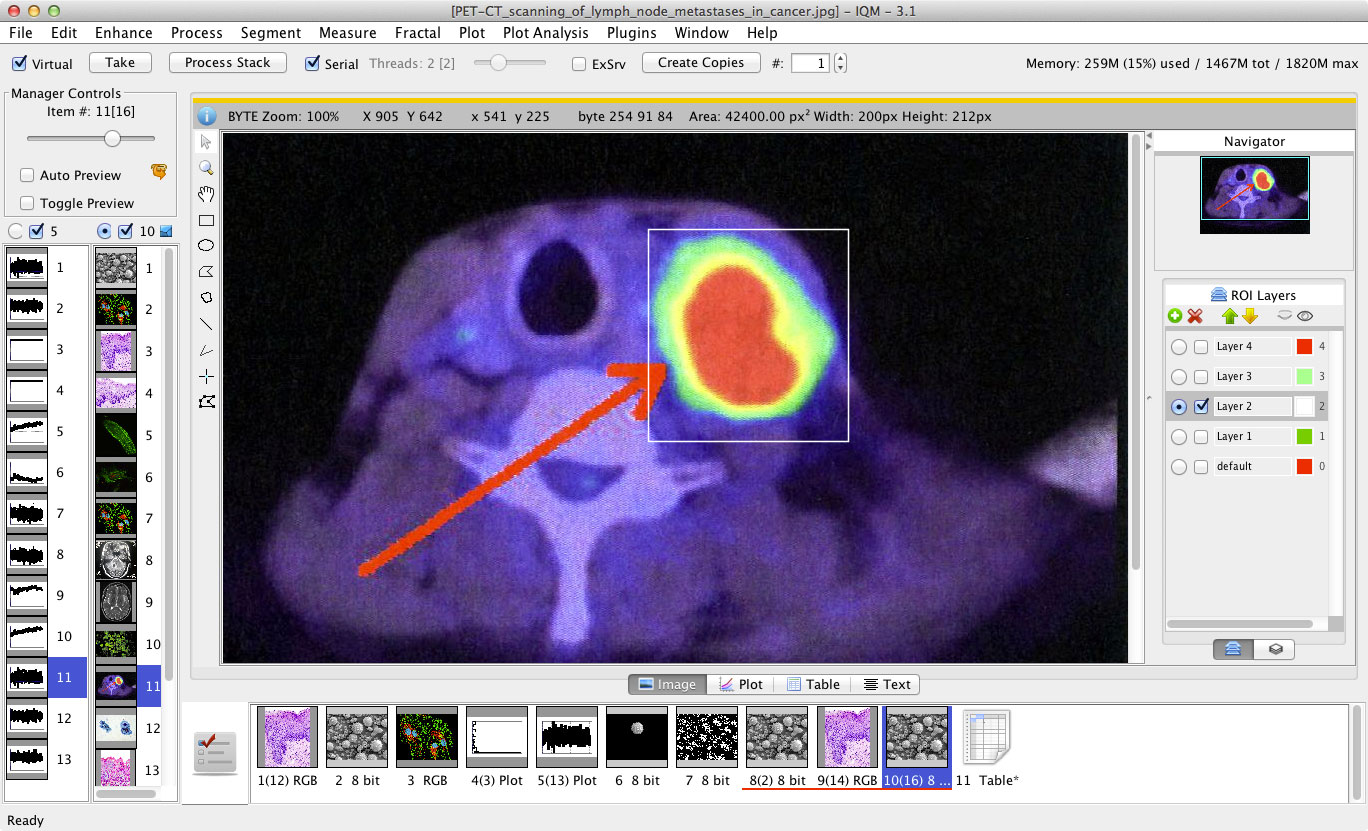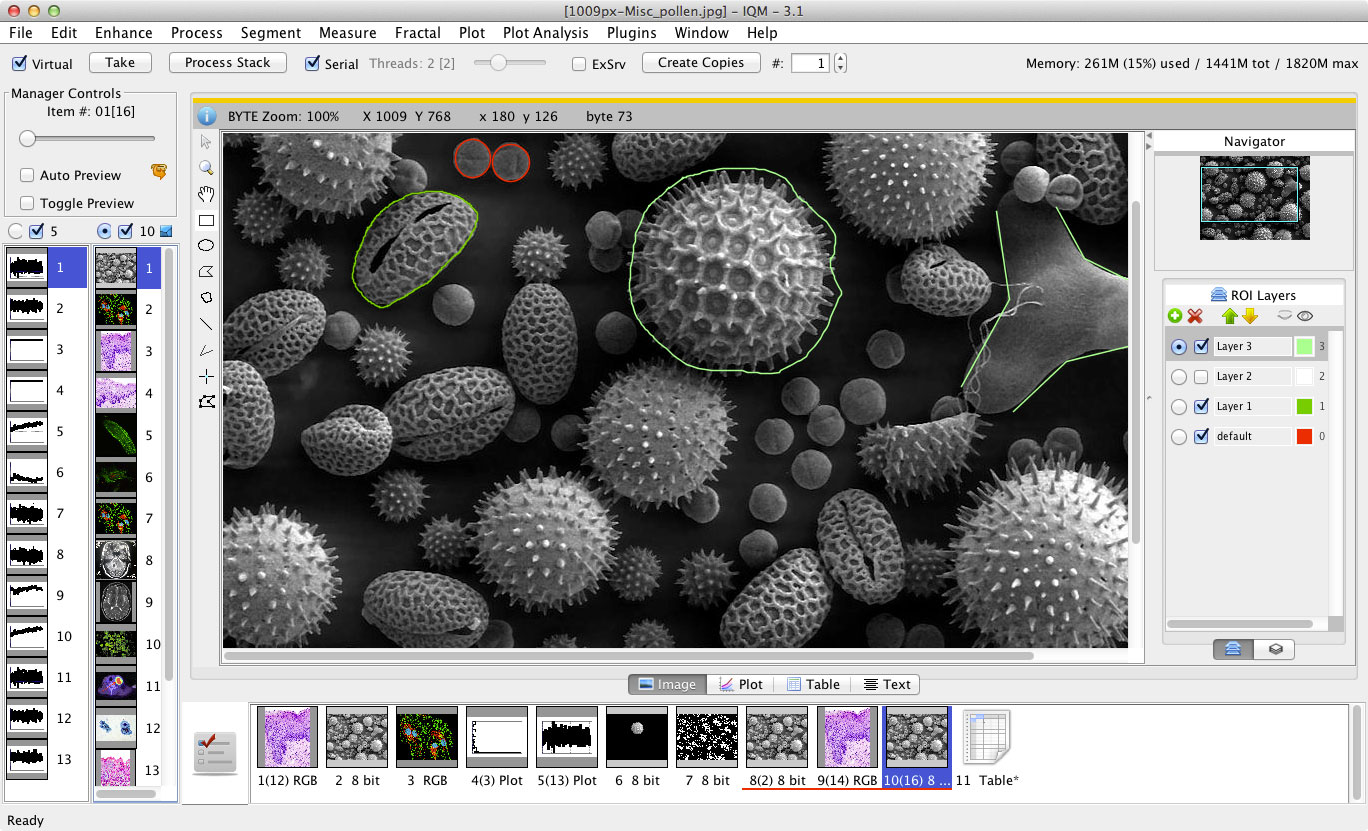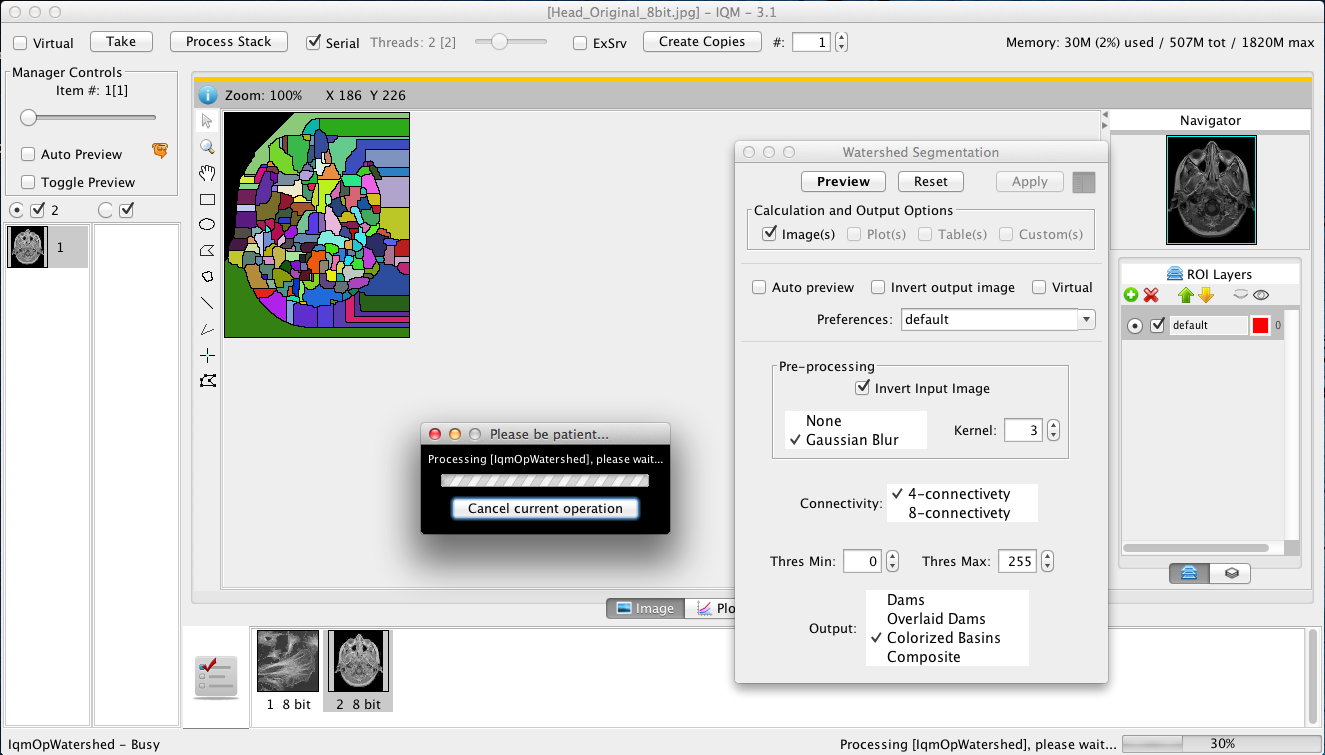IQM

IQM | Scientific Image and Signal Analysis in Java
An extensible, flexible, and open source research tool, designed for repeating convenient examination of digital images and signals.
Because quantitative analysis matters.
Features What can you do with IQM?
Image Analysis
Explore and analyze your digital images quantitatively with a set of standard image processing methods for
- image denoising and edge detection
- intensity-, region-, edge-based segmentation
- image (texture) statistics
- fractal image analysis
Signal Processing and Visualization
Explore and analyze your digital signals using methods for
- data extraction
- plotting
- signal statistics
- fractal signal analysis
Flexible Hybrid Operator Design
Mix signals and images as sources and produce heterogeneous results by processing multi-dimensional data in a single operator.
Advanced Stack Processing
Process your heterogeneous data in batches either in memory or in a "virtual" mode caching the files on the hard disk.
Graphical User Interface
Always stay informed about your current progress by tracking your processing steps visually in intermediate results in an intuitive Java Swing GUI.
Cross-Platform Application
Use the operating system of your choice. IQM runs on every platform, where a Java Virtual Machine exists, such as Windows, Mac OS X, and Linux.
Extensibility via Plugins
Need to have your ideas and algorithms implemented? - Easy: Write your own operator plugin and use it from other operators or in scripts.
Automatization via Scripting
Chaining of different operations is complex and can be summed in an automatic workflow, which we call a script. "Groovy", don't you think?
Machine Learning
Use the powerful methods of Machine Learning provided by the WEKA library. WEKA is shipped with IQM and its algorithms may either be accessed from Java code (operator plugins) directly, or from Groovy code (scripts).
Image Annotations
Annotate your image data, manage the annotations as generic XML documents, and load previously saved annotations to a new canvas.
Open Source
IQM is released under the permissive GNU General Public License version 3.0 (GPLv3). Feel free to check out a copy of the repository and extend or adapt the code to your requirements.
User Guide Application Documentation
Screenshots
Publications Articles and Conferences
- more coming soon...
2016
- I.C. Andronache, H. Ahammer, H.F. Jelinek, D. Peptenatu, A.-M. Ciobotaru, C.C. Draghici, R.D. Pintilii, A.G. Simion, and C. Teodorescu. Fractal analysis for studying the evolution of forests. Chaos, Solitons & Fractals, 91:310-318, Oct. 2016.
- M. Mayrhofer-Reinhartshuber and H. Ahammer. Pyramidal fractal dimension for high resolution images. Chaos, 26(7):073109, July 2016.
2015
- M. Mayrhofer-Reinhartshuber, D. Cornforth, H. Ahammer, and H.F. Jelinek. Multiscale Analysis of Tortuosity in Retinal Images using Wavelets and Fractal Methods. Pattern Recognition Letters, 68, Sept. 2015
- P. Kainz, H. Burgsteiner, M. Asslaber, and H. Ahammer. Robust Bone Barrow Cell Discrimination by Rotation-Invariant Training of Multi-Class Echo State Networks. In Engineering Applications of Neural Networks - EANN 2015, Rhodes, Greece, pages 390–400, Sept. 25-28 2015.
- M.A. Reiss, N. Sabathiel, and H. Ahammer. Noise dependency of algorithms for calculating fractal dimensions in digital images. Chaos, Solitons & Fractals, 78:39-46, Sept. 2015.
- H. Ahammer, N. Sabathiel, and M.A. Reiss. Is a two-dimensional generalization of the Higuchi algorithm really necessary? Chaos, 25(7):073104, July 2015.
- P. Kainz, M. Mayrhofer-Reinhartshuber, and H. Ahammer. IQM: An extensible and portable open source application for image and signal analysis in Java. PLoS ONE, 10(1):e0116329, Jan. 2015.
If you are using IQM for your work, please use this citation for your reference.
2014
- M. Mayrhofer-Reinhartshuber, P. Kainz, D. Sánchez-Quintana, Y. Macias, E. Hofer, and H. Ahammer. Semi-automated analysis of myocardial fibrosis by fractal characterization of histological images. In International Biophysics Congress, Brisbane, Qld, Australia, Aug. 3-7 2014.
- P. Kainz, M. Mayrhofer-Reinhartshuber, H. Burgsteiner, M. Asslaber, and H. Ahammer. The influence of image denoising on granulopoietic cell recognition using echo state networks. In International Biophysics Congress, Brisbane, Qld, Australia, Aug. 3-7 2014.
- P. Kainz, M. Mayrhofer-Reinhartshuber, H. Burgsteiner, M. Asslaber, and H. Ahammer. Echo state networks for granulopoietic cell recognition in histopathological images of human bone marrow. Biomedical Engineering / Biomedizinische Technik, 59(S1):S492-S495, Oct. 2014.
- M. Mayrhofer-Reinhartshuber, P. Kainz, D. Sánchez-Quintana, Y. Macias, E. Hofer, and H. Ahammer. Semi-automated detection and fractal characterization of myocardial fibrosis in histological images. Biomedical Engineering / Biomedizinische Technik, 59(S1):S616-S619, Oct. 2014.
- M. Fabrizii, F. Moinfar, H. F. Jelinek, A. Karperien, and H. Ahammer. Fractal analysis of cervical intraepithelial neoplasia. PLoS ONE, 9(10):e108457, Oct. 2014.
2013
- M. Mayrhofer-Reinhartshuber, P. Kainz, and H. Ahammer. Image pyramids as a new approach for the determination of fractal dimensions. In Proceedings of the 2013 2nd International Conference of Pattern Recognition Applications and Methods, INSTICC, Barcelona, Spain, February 15-18 2013.
- M. Mayrhofer-Reinhartshuber, P. Kainz, and H. Ahammer. Fractal characterization of tissue with the new pyramid method. Joint Annual Meeting of the Austrian Physical Society and Swiss Physical Society, Sept. 3-6 2013.
- P. Kainz, H. Burgsteiner, H. Ahammer, and M. Asslaber. Automated classification of haematopoietic compartments in the human bone marrow using reservoir computing. In International Joint Conference on Computational Intelligence IJCCI 2013, Vilamoura, Portugal, 20-22 Sept. 2013.
2008
- H. Ahammer, C. Helige, G. Dohr, U. Weiss-Fuchs, and H. Juch. Fractal dimension of the choriocarcinoma cell invasion front. Physica D - Nonlinear Phenomena, 237(4):446–453, Apr. 2008.
- H. Ahammer, J. M. Kroepfl, C. Hackl, and R. Sedivy. Image statistics and data mining of anal intraepithelial neoplasia. Pattern Recognition Letters, 29(16):2189–2196, 1 Dec. 2008.
2004
- H. Ahammer and T. T. J. DeVaney. The influence of edge detection algorithms on the estimation of the fractal dimension of binary digital images. Chaos, 14(1):183–188, Mar. 2004.
2003
- H. Ahammer, T. T. J. DeVaney, and H. A. Tritthart. How much resolution is enough? Influence of downscaling the pixel resolution of digital images on the generalised dimensions. Physica D - Nonlinear Phenomena, 181(3-4):147–156, 15 July 2003.
Contact
Institute of Biophysics
Medical University of Graz
Harrachgasse 21/IV
8010 Graz, Austria
M: iqm.mug@gmail.com


Institute of Biophysics
Medical University of Graz
Harrachgasse 21/IV
8010 Graz, Austria
M: kainzp@users.sf.net
Institute of Biophysics
Medical University of Graz
Harrachgasse 21/IV
8010 Graz, Austria
M: mmayrhofer@users.sf.net









